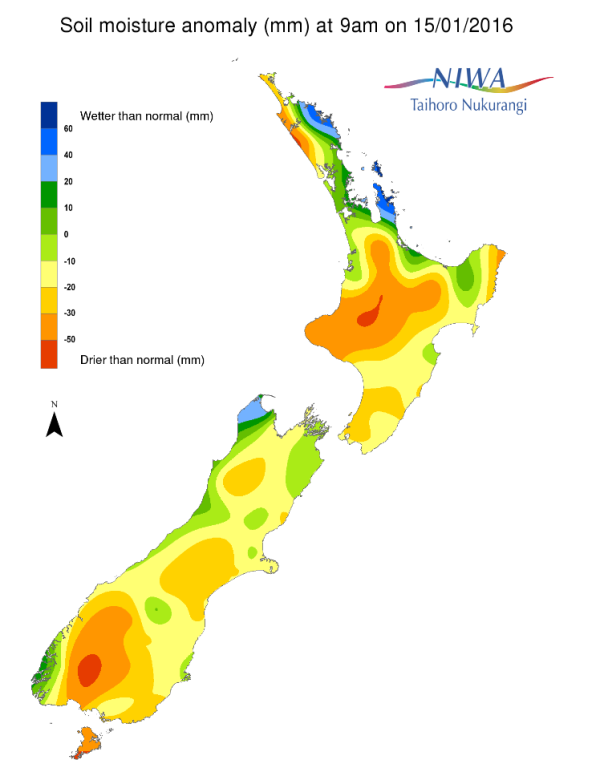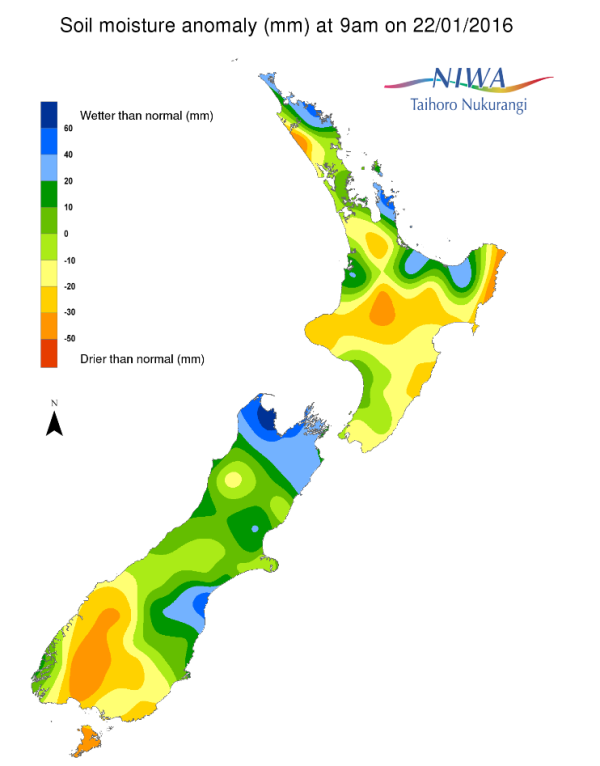A weekly update describing soil moisture across the country to help assess whether severely to extremely dry conditions are occurring or imminent. Regions experiencing these soil moisture deficits are deemed “hotspots”. Persistent hotspot regions have the potential to develop into drought.
Soil Moisture
Over the past week, soil moisture levels across the North Island have mostly remained the same or increased. The exception is from coastal Gisborne to Hawke’s Bay where soil moisture levels have decreased slightly. At this time, central Waikato, much of Taranaki, northern Manawatu-Whanganui, Hawke’s Bay, coastal Gisborne and extreme western Northland have below normal soil moisture for this time of the year. Soil moisture is near to above normal in eastern Northland south to the coastal Bay of Plenty region and in coastal Manawatu-Whanganui to parts of the Wellington region.
Across the South Island, soil moisture levels have increased rather significantly from central Otago northward over the past week. The greatest increases were found from central Otago to mid-Canterbury and from the Tasman to interior Marlborough regions. Soil moisture levels for this time of the year are generally near to above normal across the aforementioned regions. Soil moisture levels are below normal across much of Southland, and southern and interior Otago but near to above normal along the West Coast.
Outlook
Rainfall
For the North Island, little to no organised rainfall is expected through next Tuesday. Only scattered rains totalling less than 10 mm are expected across the higher terrain of Northland, the interior central portion of the Island and along western coastal Manawatu-Whanganui and Wellington. The driest weather through Tuesday will be found from the Auckland region to Taranaki and from coastal Gisborne to Hawke’s Bay where isolated falls of less than 5 mm are possible. During the mid and late week, Tropical Cyclone Victor is expected to pass northeast of the North Island, causing a more unsettled weather pattern to develop. Showers and thunderstorms will be most widespread in the eastern portion of the North Island where falls could reach 25 mm in places. Rain will be more scattered in nature in the central and western portions of the island late in the week, but isolated falls of more than 10 mm are possible.
The western and southern South Island will have a wet Saturday and Sunday. Two-day rainfall from Fiordland through the middle West Coast will exceed 25 mm in many places with amounts in the higher terrain of more than 50 mm. Falls across Southland into Otago will generally be between 10 and 25 mm with mostly less than 10 mm for the northern West Coast and the higher terrain of the Tasman region. During the early stages of next week, rain across the West and South will expand eastward and northward as low pressure passes from the Tasman over the South Island. The heaviest falls will again be along the West Coast where some flooding is possible; cumulative rainfall from the weekend into early next week may exceed 125mm in places. While the western South Island should begin to dry out later next week, southerly and easterly flows will direct showers to the east of the South Island.
Soil moisture
For the North Island, hotspot areas are present in extreme western Northland, central and southern Waikato, extreme eastern Gisborne, interior Bay of Plenty and Manawatu-Whanganui, south coastal Taranaki as well as south coastal Hawke’s Bay. Hotspots across much of the island will need to be monitored for expansion over the next several days. Mid- and late-week rains (next week) may work to reduce hotspot coverage, especially in the east.
Hotspot areas are present in Southland and Otago on the South Island, most significant across the interior of both regions. Rainfall across these regions over the weekend and into early next week will reduce hotspot size or eliminate them entirely. Additional hotspot development is not anticipated this week.
Background
Soil moisture deficit
Soil moisture deficit is the amount of water needed to bring the soil moisture content back to field capacity, which is the maximum amount of water the soil can hold.
Soil moisture anomaly
Soil moisture anomaly the difference between the historical normal soil moisture deficit (or surplus) for a given time of year and actual soil moisture deficits.
Definitions
“Extremely” and “severely” dry soils are based on a combination of the current soil moisture status and the difference from normal soil moisture (see soil moisture maps at https://www.niwa.co.nz/climate/nz-drought-monitor/droughtindicatormaps)
Soil moisture anomaly maps
Pictured below are soil Moisture Anomaly Maps, relative to this time of year. The maps show soil moisture anomaly for the past two weeks.


